The Hodges Family Collection of Fabergé
Dr. Daniel Hodges shared a selection of pieces for examination with the editors of the Fabergé Research Newsletter before the collection travels.
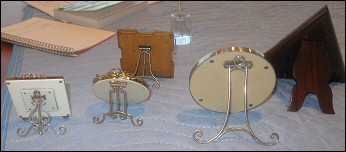
Photographs Courtesy McCanless & Wintraecken

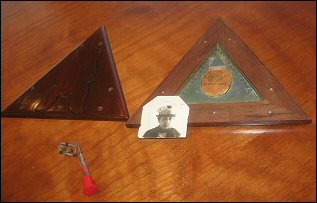
Fabergé mahogany, silver, guilloché enameled frame
by Nevalainen
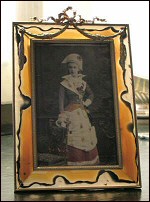
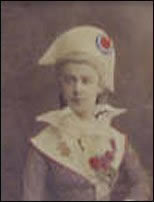
Courtesy NOMA
Fabergé silver toilet set was most likely a wedding gift in 1904 to Daria Gorchakova (née Bibikova), lady-in-waiting to Alexandra Feodorovna, from the workshop of Julius Rappoport, a supplier of wedding silver and gifts for court weddings.
April 24, 2009 New York (correction) Christie’s Russian Art
Over 50 Fabergé lots included.
May 13-14, 2009 Helsinki Bukowski’s International Spring Auction
The Silver Set, 15 pieces of furniture handmade in 1894 for the Winter Palace where Tsar Nicholas II and his family lived in St. Petersburg, has been known only from old photographs. Sold in the 1920’s by the Bolsheviks, eleven pieces have surfaced in Finland and will be sold at auction along with a variety of Fabergé objects from the same time period.
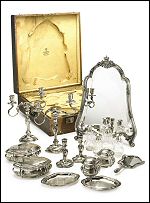
Fabergé Toilet Set
Courtesy Sotheby’s

The Silver Set
Courtesy Bukowski’s
(Updates are posted in Exhibitions on the Fabergé Research Site)
Homage to Carl Fabergé: Books – Design Studies – Photographs
Books and exhibition catalogues on the …uvre of Carl Fabergé gathered from the collections of the National Library of Russia and other St. Petersburg institutions are featured with 40 designs from the workshop of Henrik Wigström, Fabergé’s leading workmaster from 1903-17. Photos showing the premises of Fabergé in St. Petersburg and his other workshops as well as workmasters round out the venue. Text panels in English and Russian.
Fabergé authors are invited to share a complimentary copy of their publications in support of this unique exhibition.
June 6-9, 2009 London Jumeirah Carlton Tower Hotel New Russian Art Fair
Art dealer Peter London and organizer Robert Bailey are starting a fair exclusively for Russian art, including Fabergé.
Opening June 20, 2009 Amsterdam Hermitage Amsterdam
After major museum renovations the Russian Court Life venue centers on a day at the Russian court with an official reception given by the Tsar and his family. Russian, West European and exotic objects, including ten Fabergé objects, will be presented from the State Hermitage Museum in St. Petersburg.
Contains watercolor and pencil sketches covering the years 1914-16 drawn by Grand Duchess Olga Alexandrovna (1882-1960), daughter of Tsar Alexander III and his wife, Marie Fedorovna. The originals were acquired in December 2007 by the editor of this book at a Bruun Rasmussen auction and are reproduced in color with an explanatory text and relevant photographs.
Korneva, Galina and Tatiana Cheboksarova. Любимые резиденции императрицы Марии Федоровны в России и Дании – Empress Maria Feodorovna’s Favorite Residences in Russia and in Denmark.
Profusely illustrated scholarly book depicting in detail the palaces known from the miniatures of Danish Palaces Egg. Three separate editions were published between 2006 and 2008 in Russian, English and Danish. The Russian and English editions are currently out of print, the Danish edition will be available in April 2009 in the Copenhagen Amalienborg Palace shop. The authors are hopeful a second edition is forthcoming.
Skurlov, Valentin, Fabergé, Tatiana, and Victor Ilyukhin. К. Фаберже И Его Продолжатели – Carl Fabergé and His Successors: Hardstone Figures – Russian Types. St. Petersburg: Liki Rossii, 2009. In Russian.
A collective monograph in Russian (640 pages and 2500 illustrations) in which several dozen contemporary Russian stone carvers tell the reader about their achievements. The group of Fabergé “Russian National Types” is maybe the second only in importance after the approximately same number of Fabergé Easter eggs. Interest in Fabergé hardstone figures by collectors is very high, but they have not yet been studied and described well. This book is one of the first attempts to compile all known materials about the successors of Fabergé, and includes a chapter on Fabergé hardstone figures. (Review by Galina Korneva)
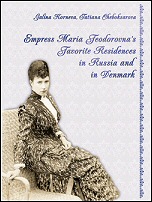
Empress Maria Feodorovna’s
Favorite Residences in Russia
and in Denmark
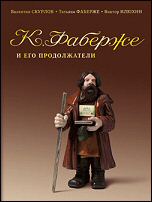
Fabergé and His Successors:
Hardstone
Figures – Russian Types
Authors carefully investigated the history of almost three centuries of the St. Petersburg antiques market, and for the first time give readers the opportunity to review archival documents of the period. The book is richly illustrated and could be used as a comprehensive guide for specialists and interested readers. Two chapters include material on Agathon Fabergé as a collector and objects from his collection in the Hermitage, and there are also 24 pages listing objects purchased by Emperor Nicholas II from 1894-1905. (Review by Galina Korneva)
Faber, Toby. Fabergé Eggs: One Man’s Masterpieces and the End of an Empire, just issued as a paperback. Author will lecture at the London Royal Asiatic Society in aid of a charity on April 28, 2009.
David Tovey, art historian specialising in St. Ives art wants to know if any photos or paintings by Nicholas Fabergé are extant, and can be traced to St. Ives, an art colony in Cornwall, UK.
The name of Nicholas Fabergé as an ‘artist and photographer’ and ratepayer for a studio in St. Ives appears in the Rate Books of 1914, 1917 and 1925. Nicholas came to London in 1909 to work with Henry Charles Bainbridge in the London Fabergé branch, which had opened in 1903. His interest in art and photography must have led him to St. Ives where in 1914 he is the ratepayer for No. 5 Piazza Studios fronting on to Porthmeor Beach. In 1917, the Fabergé shop ceased trading and Nicholas returned to St. Ives and is again recorded as the ratepayer for No 5. No other Rate Books are extant until 1925, but, in the interim, he seems to have switched studios, as he is then shown as the ratepayer for No. 1 Piazza Studios. However, as others are known to have used this studio in the early 1920s, it would seem his involvement with the colony had then ceased.
Cleveland Museum of Art
The museum has added a Fabergé cat, three goldfish in an original box, and an agate and gold cigarette case from the Howard and Cara Stirn Collection of European Decorative Arts.
Fabergé Symposium
A reader has suggested a Fabergé symposium be held every two years, alternating between Hillwood Museum in Washington and the Hermitage Museum in Russia for the purpose of exchanging information between Fabergé scholars and enthusiasts.
Yusupov Egg Miniatures
Question from a reader — is the miniature shown in Odom, Fabergé at Hillwood, 1996, 52, indeed one of the original miniatures (no longer with the egg) of the Fabergé Yusupov Egg? The black and white miniatures of Felix and Nicholas Yusupov below are illustrated in Snowman, The Art of Carl Fabergé, 1962, pl. 391-2.

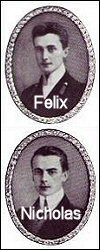
Left: Hillwood Miniature
Inquiry from Ulla-Tillander-Godenhielm: Has anyone seen cigarette cases in gold marked HK (Heikki Kaksonen), St. Petersburg, 1908-17? This workmaster was one of the main makers of cigarette cases in Wigström’s workshop at Fabergé before he established himself as an independent master, and later worked in Finland.
An archival Wartski photograph of the Blue Serpent Egg (left below) compared to a recent illustration (right below) in Artistic Luxury: Fabergé, Tiffany, Lalique (2008, 65) shows two different front panels under the stationary snake indicating the hour, suggesting a rotation of the base has taken place.
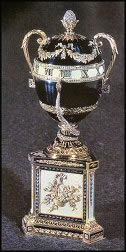
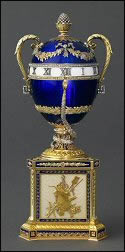
Tinder Cords
Fabergé enthusiasts intrigued by the tinder cords on Fabergé cigarette cases discovered that these cords were an “anachronistic reminder that before the convenience of sulfur matches one had to use tinder and a stone to create the flame to light one’s tobacco”. (Traina J., The Fabergé Case: From the Private Collection of John Traina, 1998, 171.) Two questions remain: Were the cords added for decoration only by Fabergé, and when were these tinder cords actually used?
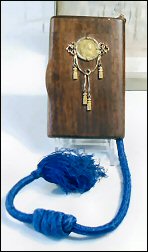
Courtesy Dr. Hodges
The editors of the Fabergé Research Newsletter have been advised the term “patch box” should not be applied to very small Fabergé boxes. Historically, patches went out of fashion with Madame de Pompadour (1721-1764).
Workmaster Update
Ulla Tillander-Godenhielm advises the entry AB. Unidentified Workmaster (Lowes & McCanless, Fabergé Eggs, 2001, 178) is incorrect and should refer to Abraham Beilin (Beilin and Son, ibid., 185). She further states Fabergé and many other companies (“… also my great grandfather and grandfather Alexander Tillander …”) turned for assistance to Abraham Beilin when they did not have the capacity to fulfill orders.
Two examples on the misidentification of the maker’s mark AB are:
Keefe, Masterworks of Fabergé: The Matilda Geddings Gray Foundation Collection, 1993, 144, and all subsequent publications for this collection. The misidentification was originally an error by Dr. Tillander-Godenhielm.
Sotheby’s London, 26 November 2008, lot 163 (identified here as Andrei Bragin, a silversmith who exclusively produced holloware and flatware. Valentin Skurlov is credited with recognizing this mistaken identity problem in Lowes & McCanless, 185). This latter cigarette case, decorated with an imperial double-headed eagle, is in an original étui of A. Tillander and was commissioned by the Cabinet of His Imperial Majesty as an Imperial gift.

